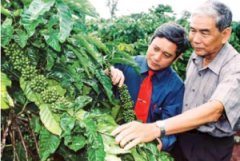The birthplace of coffee, Ethiopian coffee.
In the world of coffee, there are countless stories and reports about Ethiopia: the birthplace of coffee, the story of shepherds, black gold, and so on.
Ethiopia's coffee culture and popularity are so shocking that even some coffee bars in the airport have four professional semi-automatic coffee machines, whether in urban or rural cafes, western restaurants, Chinese restaurants or hotel bars. Two and three professional coffee machines can be seen everywhere, while their coffee is very civilian, selling only 1~7BIRR (about RMB 30 to 2.5 yuan).
The Ethiopian Coffee exporters Association arranges the overall process of the Ethiopian coffee industry chain: coffee farmers (Coffee Alliance) purchasers and exporters (Coffee Export Association) National quality Inspection Center buyers around the world; Ethiopia is not only the "birthplace of coffee" but also the place of coffee pilgrimage.
Ethiopian coffee beans are mainly Arabica, and the whole Ethiopia is located in the high sea area: "Sidamo" is 1400 ~ 1900 meters in the sea and "Yega Sheffield" is more than 1900 meters in the sea. In addition to geographical advantages, Ethiopia has fertile soil, cool climate in the morning and evening, and plenty of sunshine at noon, all of which provide a very excellent natural environment for growing coffee. Compared with some advanced countries, Ethiopia's original planting method is the key factor of Ethiopia's high-quality coffee beans.
1. Organic cultivation, without chemical fertilizers
two。 Pick by hand to make sure that every coffee bean is picked in a ripe state
3.90% are grown by small farmers-every family has grown and drank coffee for generations, which means that every one of them is an expert in growing coffee; under the conditions of weather, geography and harmony, it is inevitable for Ethiopia to become a country of coffee that we admire!

Important Notice :
前街咖啡 FrontStreet Coffee has moved to new addredd:
FrontStreet Coffee Address: 315,Donghua East Road,GuangZhou
Tel:020 38364473
- Prev

Coffee culture how is coffee recorded in the Compendium of Materia Medica?
How is coffee recorded in the Compendium of Materia Medica? it is recorded in the Compendium of Materia Medica: [coffee] shrubs, fruit kernels can be used as medicine, sex temperature, bitter and sour taste, refreshing and refreshing, stomach digestion. Can treat mental malaise, yang qi block, children accumulated food. Incompatibility: Codonopsis pilosula, Croton, alum, cold noodles. Usage: processed into powder, which is called Tishen Powder. Two dollars a day, one for milk and one for sugar.
- Next

Cultural History of Fine Coffee an introduction to the History of Coffee in Vietnam
Vietnam has several professional coffee kings whose outstanding contributions have enabled Vietnam to grow into the world's second largest coffee producer outside Brazil in recent years. Several other coffee figures who have contributed silently are DoanTrieuNhan, who has been focusing on the growth of national coffee production since the end of the Vietnam War, which can be said to be the main planner of Vietnam's coffee growth plan. DoanTrieuNha
Related
- How did the Salvadoran coffee industry develop in Central America?
- What exactly does the golden cup extraction of coffee mean?
- The Origin of Coffee flower
- [2023 Starbucks World Earth Day] there are more meaningful things besides free Starbucks coffee!
- What kind of coffee is there in Spain? 9 Flavors of Spanish Coffee
- Aromatic African coffee| Kenya's coffee culture and historical production area
- Liberica Coffee Bean knowledge: the characteristics of Liberian Coffee beans of the three original species of Coffee beans
- The origin and formula of Spanish latte introduces the taste characteristics of Bombon coffee in Valencia, Spain.
- How to adjust the solution of over-extracted coffee
- What is the tasting period of coffee beans? What is the period of coffee and beans? How should coffee wake up and raise beans?

